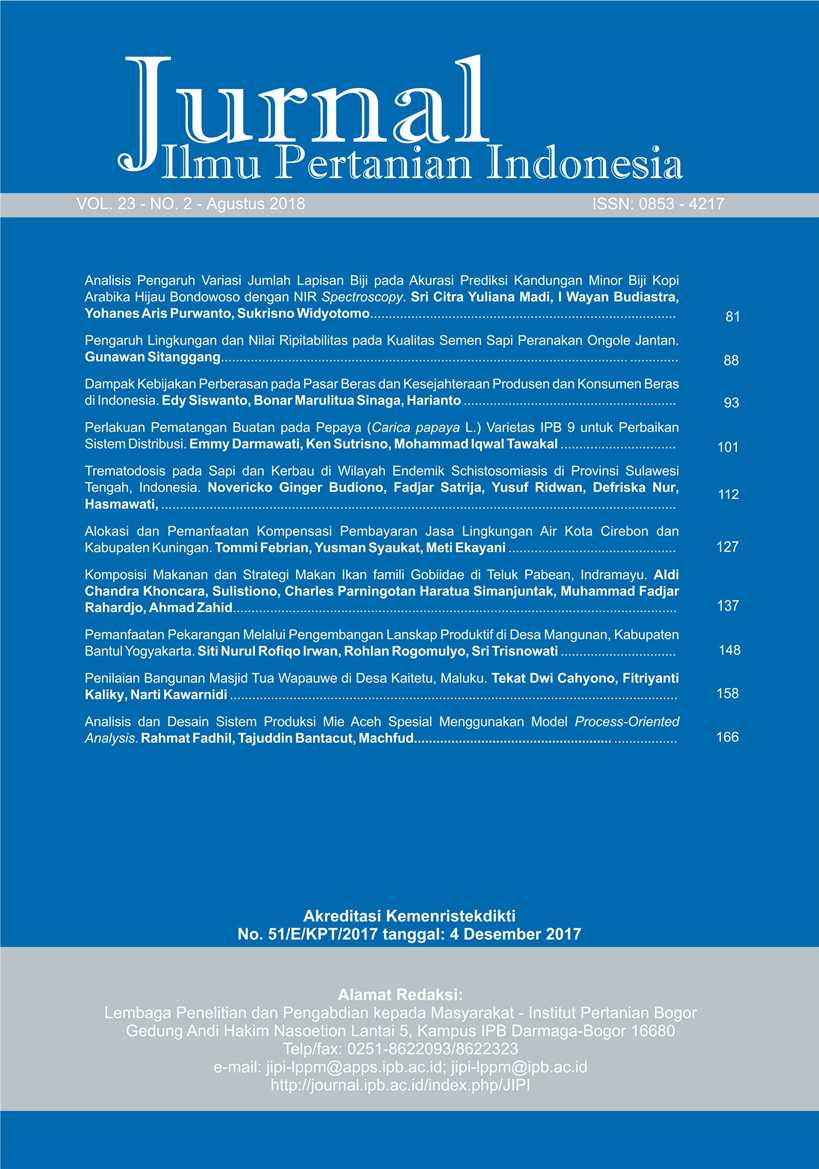Analisis Pengaruh Variasi Jumlah Lapisan Biji pada Akurasi Prediksi Kandungan Minor Biji Kopi Arabika Hijau Bondowoso dengan NIR Spectroscopy
Abstract
Void space in the bean layers will lead to the occurrence of non-fully interacted radiation (NFIR) affecting the reproducibility of NIRS measurements. Void space in addition to being affected by particle size is also influenced by the number/thickness of the bean layers. The objective of this study was to analyze the effect of number of bean layer variation on prediction accuracy of caffeine, chlorogenic acid and trigonelline in Bondowoso green Arabica coffee beans by NIR Spectroscopy (NIRS). The study was conducted using three kind of layers, i.e. 3, 4, and 5 layers, with 100 samples each. Samples were measured by FT-NIR spectrometer in wavelength of 1.000-2.500 nm. The pretreatment method used were second derivative (dg2), the combination of first derivative (dg1) and Multiplicative Scatter Correction (MSC), and the combination of dg2 and MSC, while calibration method used was Partial Least Square (PLS). The results shows that the accuracy of 5 layers was better than 3 or 4 layers. The best calibration and validation for caffeine was obtained by dg2 pretreatment and 6 factors of PLS (r = 0.99; SEC = 0.01%; SEP = 0.01%; and RPD = 5.40), for chlorogenic acid was by dg2 pretreatment and 5 factors of PLS (r = 0.99; SEC = 0.09%; SEP = 0.09%; and RPD = 4.76), whereas for trigonelline was by combination of (dg2, MSC) and 5 factors of PLS (r = 0.99; SEC = 0.01%; SEP = 0.01%; and RPD = 4.86). Therefore, the 5 layers can be used as a reference in NIRS measurement of coffee beans.
Downloads
References
Andarsuryani, Purwanto YA, Budiastra IW, Syamsu K. 2014. Prediksi kandungan katekin gambir (Uncaria gambir roxb.) dengan spektroskopi NIR. Jurnal Teknologi Industri Pertanian. 24(1): 43-52.
Ayu PC. 2017. Pengembangan model penentuan kandungan pembentuk flavour biji kopi Java Preanger menggunakan NIRS. [Tesis]. Bogor (ID) : Institut Pertanian Bogor.
Caporaso N, Whitworth MB, Grebby S, Fisk ID. 2018. Non-destructive analysis of sucrose, caffeine and trigonelline on single green coffee beans by hyperspectral imaging. Food Research International. 106: 193-203. https://doi.org/10.1016/j.foodres.2017.12.031
Chang CW, Laird DA, Mausbach MJ, Hurburgh CR. 2001. Near-infrared reflectance spectroscopy principal components regression analysis of soil properties. Soil Science Society of America Journal. 65: 480-490. https://doi.org/10.2136/sssaj2001.652480x
[GAEKI] Gabungan Eksportir Kopi Indonesia. 2017. [internet] [diunduh 2017 Juli 8]. Tersedia pada: http://gaeki.or.id/areal-dan-produksi/.
Huck CW, Guggenbichler W, Bonn GK. 2005. Analysis of caffeine, theobromine and theophylline in coffee by near infrared spectroscopy (NIRS) compared to highperformance liquid chromatography (HPLC) coupled to mass spectrometry. Journal of Analytica Chimica Acta. 538: 195-203.
Lammertyn J, Peirs A, De Baerdemaeker J, Nicolaï B. 2000. Light penetration properties of NIR radiation in fruit with respect to nondestructive quality assessment. Postharvest Biology Technology. 18: 121-132. https://doi.org/10.1016/S0925-5214(99)00071-X
Osborne BG, Fearn T, Hindle PH. 1993. Practical NIR Spectroscopy with Application in Food and Beverage Analysis. Singapore (SG): Longman Singapore Publishers.
Rosita R, Budiastra IW, Sutrisno. 2016. Prediksi kandungan kafein biji kopi Arabika Gayo dengan Near Infrared Spectroscopy. Jurnal Keteknikan Pertanian. 4(2): 179-186.
Shan J, Suzuki T, Suhandy D, Ogawa Y, Kondo N. 2014. Chlorogenic acid (CGA) determination in roasted coffee beans by Near Infrared (NIR) Spectroscopy. Engineering in Agriculture, Environment and Food. 7: 139-142.
Sridevi V, Giridhar P. 2013. Influence of altitude variation on trigonelline content during ontogeny of Coffea Canephora fruit. Journal of Food Studies. 2(1): 62-72.
Yoon J, Kim J, Duy PK, Kim M, Kang S, Chung H. 2013. Diffuser-incorporated transmission NIR measurement for reliable analysis of packed granular samples. Royal Society of Chemistry. 138: 4922-4932. https://doi.org/10.1039/c3an00514c
This journal is published under the terms of the Creative Commons Attribution-NonCommercial 4.0 International License. Authors who publish with this journal agree to the following terms: Authors retain copyright and grant the journal right of first publication with the work simultaneously licensed under a Creative Commons Attribution-NonCommercial 4.0 International License. Attribution — You must give appropriate credit, provide a link to the license, and indicate if changes were made. You may do so in any reasonable manner, but not in any way that suggests the licensor endorses you or your use. NonCommercial — You may not use the material for commercial purposes.
10.17728/jatp.13827
10.1088/1755-1315/644/1/012001























